|
| | |
|
|
| | |
| |
| | |
GOI & Leningrad "Original" | |
| |
| | |
| | |
PK4705. Camera "GOI".
Prototype of a 35-mm rangefinder camera, dating from the second half of the 1940s.
Combined collimated viewfinder (van Albada principle) and coincident-image rangefinder with a small round eyepiece (long-base rangefinder, b = 7cm, v = 0,7x, as in the Contax/Kiev). Uniformly semi-transparent golden-tinted van Albada collimated Galilean viewfinder rendering a greenish viewfinder image. Standard lens GOI Industar 2,5/50mm (four lenses in three groups, Tessar style, calculated at the Institute Vavilov = GOI in 1940), collapsible, uncoated, in an unique three-claws bayonet and with filter ring 40,5 x 0,5. Each of the interchangeable lenses has its own helicoid (focusing from infinity to nearer than 0,8m). |
Focusing is done by turning a small chrome plated knurled wheel on the left lower side of the lens mount. Along with the Industar standard lens an uncoated GOI Uran-14 2,5/35mm wide-angle lens is known (calculated in 1945 by GOI). Horizontally traveling focal plane shutter using sliding black painted sheet metal plates; speeds 1 – 1/500 sec.
The shutter speeds are controlled by a vertical knurled wheel in the camera top. Frame counter below the rewinding knob (0 – 40). Film transportation (with a single claw engaging the upper film perforation holes) and shutter cocking is achieved with a (folding) sliding lever mechanism on the rear side of the camera top. As the shutter plates need more space than a textile shutter would, the film cassettes moved forward and are responsible for the two bulges on the camera front, that, on the other hand, make the camera quite comfortable to hold. The film pressure plate retracts when the film is transported (for easier winding; patent by Burmistrov). Detachable back (Contax/Kiev style). Only one example of this beautiful camera is so far known (# 1686). | |
| | PK4705 - GOI Prototype camera from private coll. |
| | |
PK4710. Original “Leningrad” camera Developed on the basis of the camera “GOI” with identical camera body layout, film transportation and shutter system, but with many details improved. The concave mirror of the van Albada viewfinder is no longer uniformly semi-transparent (=semi-opaque), but fully silvered in the periphery and fully transparent all other parts (an ingenious modification of the van Albada principle), which results in a substantially brighter viewfinder image and brighter, better defined frames. Enlarged rectangular eyepiece, collimated frames for 3,5cm, 5cm and 8cm. Frame counter relocated to the right under the release knob. Standard lens GOI Jupiter-3 1,5/50mm lens in a unique mount somewhat reminiscent of the original Contaflex (of 1935): to mount the lens you set the lens to infinity and simply insert it into the body until it clicks home, fixed by two claws. For removal two rectangular knobs in 90° orientation to the claws are pressed, which unlocks the claws, so that the lens can be simply pulled out. |
Still each lens has its own helicoid, but focusing is now done with a radial lever that is arrested at infinity position (infinity to 0,85m: a 180° turn).
Only a handful of these cameras were obviously made, probably at the end of the 1940s. Planned lenses: GOI Orion-15 6/2,8 cm (calculated in 1944, a Topogon type lens), GOI Uran-14 2,5/3,5 cm (calculated in 1945, an original double-Gauss design of seven lenses in six groups – a similar design was used 16 years later by Dr. Mandler in the Leitz Canada Summilux 1,4/35 of 1961), GOI Industar-33 2,8/8 cm (calculated in 1944, a straight Industar of 4 lenses in 3 groups). The standard lens GOI Jupiter-3, a Zeiss Sonnar recalculated to fit the demands of the Soviet optical glass industry at the Institute Vavilov (GOI) in 1940, was faintly coated from the start (partly light blue, partly light golden tinted coatings), as were all other lenses for the original Leningrad camera. This is an esthetic, simply beautiful, yet ingenious and extremely usable camera.
Dimensions: 82 x 53 x 138 mm, weight 800g (with standard Jupiter-3 lens; 600g body only). | |
| | PK4710 - Leningrad Prototype camera from private coll. |
| | |
|
|
| |
| | |
| Leningrad "The missing link" |
| |
| | |
PK4720. Prototype - Conceived by I.Shapiro. The first impression is that there is little connection between this camera and PK4705 or PK4710. The base of the rangefinder is shorter, the appearance is more classical, and the camera is motorized. However, the veritable missing link has the same shutter speed selector knob, now moved back behind the zeroing button of the frame counter, the frame counter itself being placed in front of this knob) but this time with a vertical-running metal shutter (in 1952!). The lens mount, with an original bayonet (like the Alpa reflex c. 1945). Thus, even if some of the details remind one of the PK4710, this camera shows signs of the future series-produced Leningrad. And if the attics of LOMO have not yet been completely emptied, maybe the future still holds some neat little surprises for us (source: The Authentic Guide to Russian and Soviet Cameras by J.L.Princelle, 2nd edition, 2004). | |
| | PK4720 - Leningrad prototype camera from private coll. |
| | |
PK4725. My very first time to see Leningrad markings together with GOMZ logotype already. Very similar to PK4720, but with changed design of shutter advance knob, shutter speeds knob, etc.
Sample opposite from LOMO (Russia) archives. | |
| | PK4725 - Leningrad prototype camera. |
|
|
| | |
| |
Leningrad "Classic" | |
| |
This camera was one of few completely original developments of Soviet photographic industry. And it actually proved to be “window into Europe”, after earning the highest reward - Boundary- with - on the world exhibition 1958 g. in Brussels. About these 71 thousand cameras were released in twelve years from 1956 through 1968 g., by Leningrad plant [GOMZ]. It was planned as the camera of professional level, “which on its outstanding technical specifications, design device, finishing and formulation can satisfy each, who acquired it [2]. | | |
|
| | |
| | |
Produced: 1956-1966
Name: „Ленинград“
Producer: GOMZ-LOMO
Frame size: 24x36 mm.
Lens: Jupiter-8 2/50.
Shutter: 1s-1/1000s + B. Quantity: 76.385 units.
| 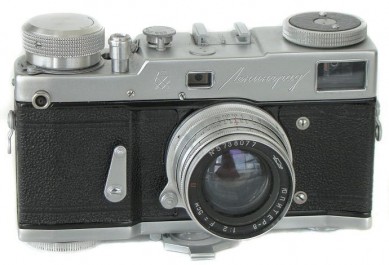
|
| | PK4805 - Leningrad camera. |
| | |
|
|
| |
1st version (2 screws) | |
| | |
| |
| | |
PK4780. The prototype of "classic" Leningrad camera. The several minor differencies are the height of the baseplate, 2mm lower, and the position of the release button, which was judged to bee too close to the knurled button of the mechanical motor. You can see more visual differencies on the top plate either.
Camera opposite from private collection in Europe. | 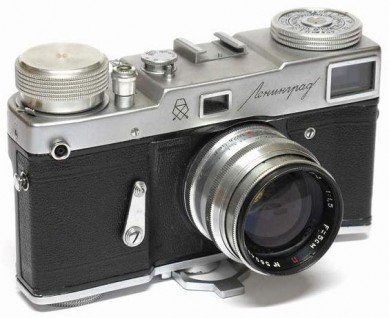
|
| | PK4780 - Leningrad prototype camera. |
| | |
PK4785. Prototype camera identical to PK4780, but with additional lid for vertical finder adjustment on the top plate (see fragment below). Shutter release knob in the same position, close to the knurled button of the mechanical motor. This version of Leningrad camera can be found easiely on every single Leningrad manual guide. Never happened to see it alive, but this camera exists for sure.
| 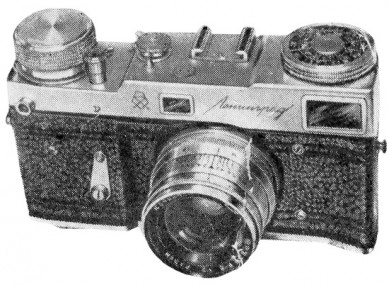
|
| | PK4785 - Leningrad prototype camera. |
| | |
PK4790. Another prototype of "Classic" Leningrad camera. Released in 1956. Camera visually similar to PK4780, but with shutter release button moved to the center of the top plate (see picture opposite). An additional screw for horizontal finder adjustment on the frontplate already. Changed design of film rewind knob. This particular sample was announced at "Stankoimport" ("Stankoimport" was responsable for soviet cameras export these years) cameras catalogue in 1957. Never happened to see it alive, but this camera really exists! | 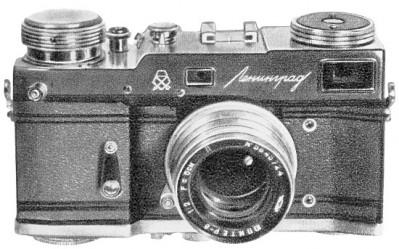
|
| | PK4790 - Leningrad prototype camera. |
| | |
PK4795. Another prototype camera, released in 1956. Camera almost identical to the 1st productional version (see PK4805 below), but without lid for vertical finder adjustment on the top plate yet. The shutter comes without serial number inside the body yet. Slightly different details on the top plate (see picture below). 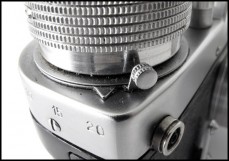
| 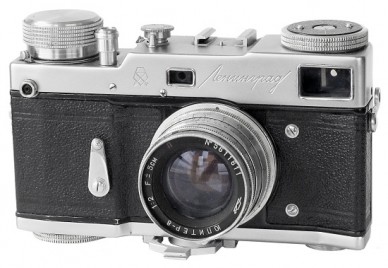
|
| | PK4795 - Leningrad #560186. |
| | |
PK4805. An earliest so far known productional version of Leningrad. Although very few cameras were released in early 1956, the big majority of these uncommon cameras have "57" (1957) date prefix on theirs serial numbers. 2 screws on body yet. Old design of strap lugs. Shutter speeds: 1s, 1/2s, 1/5s, 1/10s, 1/25s, 1/50s, 1/100s, 1/250s, 1/500s, 1/1000s + B. Plain surface of shutter advance knob. The balancing foot has special cut-outs. "Peremotka" word in memo disk, which was typical on earliest cameras only (see picure below). Take-up spool is white metal, intead of black painted ones on regular cameras. | 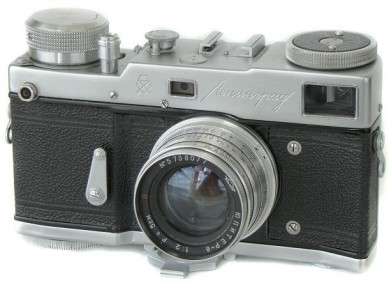
|
| | PK4805 - Leningrad #573152. |
| | |
These early Leningrad cameras came into the market with anniversary boxes "250th Birthday of Leningrad". Although the 250th Birthday had to be celebrated in 1953, the festivity were postponed because of Stalin's death (5th March, 1953). And only 4 years after (in 1957) soviet leader Nikita Chruschev have decided to celebrate the 250th Birthday of Leningrad ... 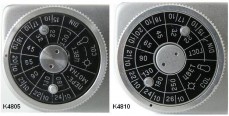
| 
|
PK4805 and PK4810 memo disks. | Leningrad PK4805 Anniversary box. |
| | |
PK4806. Camera identical to PK4805, but with regular strap lugs already (see K4810 below). Plain surface of shutter advance knob. The balancing foot has special cut-outs as on K4805 (see picture opposite). "Peremotka" word in memo disk, which was typical on some earliest cameras only. An earliest known camera has s/n #580118 (eBay 2010). | 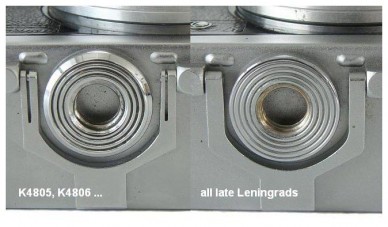
|
| | PK4806 - Leningrad camera. |
| | |
PK4807. Although regular Leningrad camera was intended for appr. 15 shots continiously, this is very 1st GOMZ attempt to create more powerful mechanical motor for 50 shots. Camera opposite from private collection in Europe.
PK4810. Camera identical to PK4805, but with regular strap lugs already (see picture below). New memo disk without word "Peremotka" already (see picture above). No more cut-outs on the balancing foot. Though very few cameras were released in 1957, the big majority of them - in 1958. 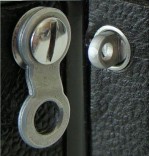
| 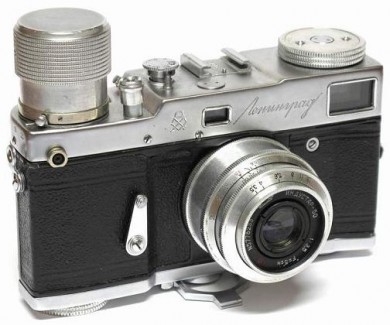
|
PK4805 and PK4810 strap lugs. | PK4807 - Leningrad camera. |
| | |
PK4815. Camera identical to PK4810, but without date prefix in serial number already (c. 1958). Only very few cameras with 2 screws on the frontplate are known to exist. Need to mention, that all Leningrad cameras have shutter number inside the body (see picture below). 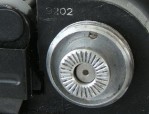
| 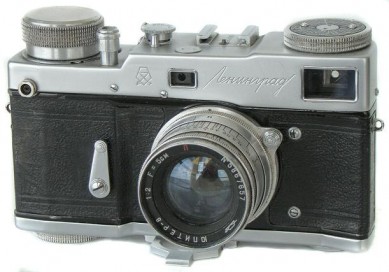
|
| | PK4815 - Leningrad #001058. |
| | |
|
|
| |
2nd version (4 screws) | |
| |
| | |
PK4820. An earliest version of regular Leningrad with 4 screws on the frontplate already. Very few cameras with date prefix in serial number were released in 1958. But the most interesting thing is, that particular camera is fully made in GOMZ, since fitted with never seen before Jupiter-8 Gomz lens!!! 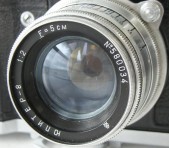
| 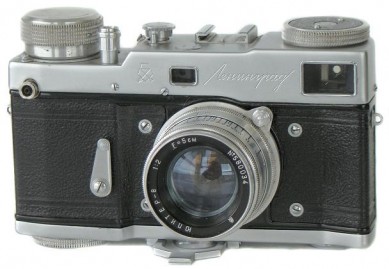
|
| | PK4820 - Leningrad #589346. |
| | |
PK4823. Very unique specimen with 2 extra switches - speeds selectors. The first switch located above the selftimer to select 3 or 6 images per second. The second rectangular switch to select a single shot or sequence operation.
Camera opposite from privte collection in Europe. | 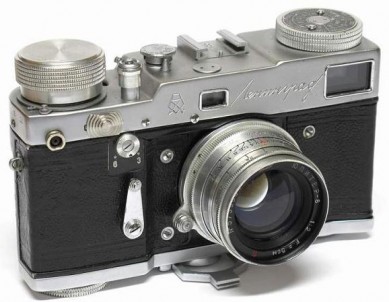
|
| | PK4823 - Leningrad camera. |
| | |
PK4825. Camera identical to PK4820, but without date prefix in the serial number already. The same shutter speeds with 1/25s yet. Very few cameras have an additional "CDELANO B CCCP" engravings on shutter advance knob (see picture below).
PK4830. Changed film memo disk. Though old version has raised characters on the surface, new one is totally painted already. | 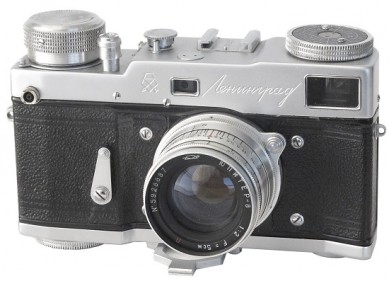
|
| | PK4825 - Leningrad #006508. |
| | |
PK4835. Date prefix in serial number again (c.1960). The surface of shutter advance knob becoming graved now (c.1961). Still old sequence of shutter speeds. No more decorative rims around the finder's windows on some cameras (see picture opposite). Some export cameras cameras are known to exist.
PK4840. Camera identical to PK4835, but with new shutter speeds already: 1s, 1/2s, 1/4s, 1/8s, 1/15s, 1/30s, 1/60s, 1/125s, 1/250s, 1/500s, 1/1000s + B (one additional speed added!). This type released in 1961-1965 with one exception (see type PK4845 below). | 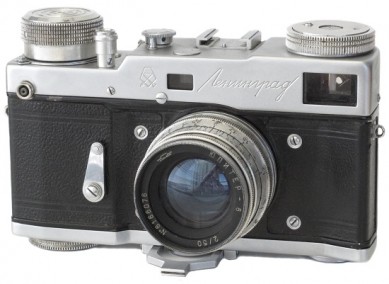
|
| | PK4835 - Leningrad #619261. |
| | |
| | |
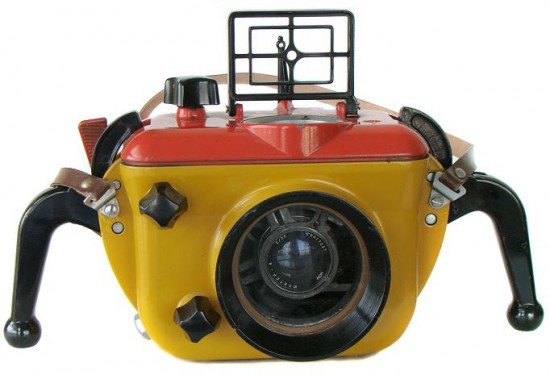
|
| |
| |
| | |
PK4840 - Leningrad #646224 with underwater housing "KRAB" (Lomo). |
| | |
| | |
| | |
PK4845. A limited batch of Leningrad (1963) have new serial numbers coding system. Only the 1st digit "3" indicates the year of camera release now ("3" stands for 1963). No otherwise different from K4840.
PK4850. Very uncommon type with big shutter advance knob for 50 shots. Was intended for military needs and diving. This camera has regular date prefix in the 5-digits serial number. | 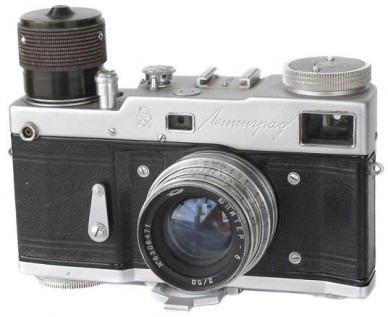
|
| | PK4850 - Leningrad #63021. |
| | |
PK4855. Totally black version with oversized shutter advance knob again. Half-frame (24x24mm) camera without viewfinder, rangefinder and selftimer. 2 shutter speeds only: "M" (9) and "B". Fitted with "T-22" 4.5/40mm lens. Was used for soviet police - "Militia" needs.
Camera opposite from private collection in Europe.
| 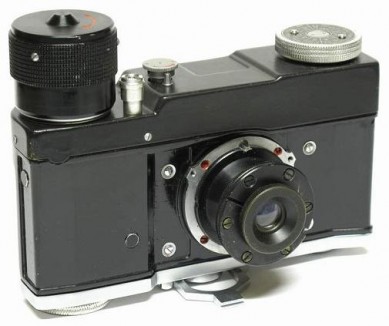
|
| | PK4855 - Leningrad camera. |
| | |
PK4857. Camera identical to PK4855, but with standard black leather coverings. An accessory shoe on the top plate. Serial number engraved on an accessory shoe (see picture below). Fitted with "Barbus-2" 2.5/28mm lens.
| |
| | PK4857 - Leningrad #63009. |
| | |
PK4860. Less common to find export version of the particular camera. "Leningrad" markings in Roman characters. "Made in USSR" engravings on shutter advance knob. No otherwise visually different. 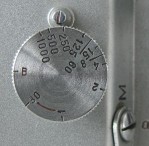
| 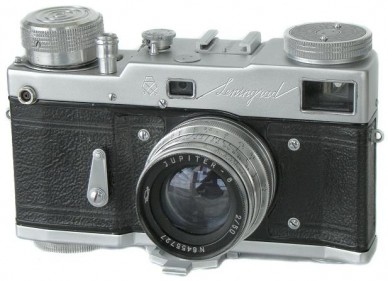
|
| | PK4860 - Leningrad #646061. |
| | |
PK4865. An unique specimen again. The particular camera has shutter release knob on the frontplate (like camera "Start" from KMZ). Redesigned selftimer lever.
Camera opposite from private collection in Europe. | 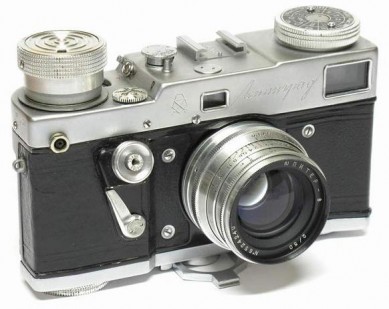
|
| | PK4865 - Leningrad camera. |
| | |
PK4870. Seems to be the latest version of the Leningrad camera with new LOOMP (LOMO) logotype on the top plate. "LOMO" logo embossed on brown leather Leningrad's case. Slightly changed nameplate's inscription. "Made in USSR" engravings on shutter advance knob (see picture below). Some cameras come without decorative rims, oulined on finder's windows. An earliest so far known camera has s/n #641721 (A.Nikitin coll.).
| 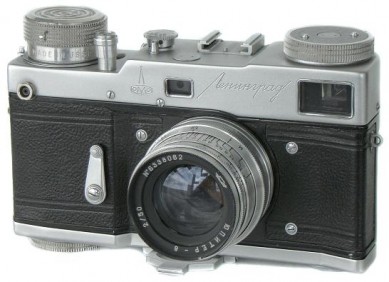
|
| | PK4870 - Leningrad #650754. |
| | |
PK4873. Camera identical to PK4870, but with reduced "LOMO" logotype on the top plate (see picture opposite).
PK4875. Camera identical to PK4873, but with export markings on the top plate. Reduced "LOMO" logotype on the top plate. No otherwise different. Very uncommon to find nowadays.
| 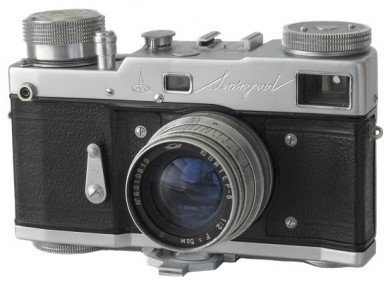
|
| | PK4875 - Leningrad #646991. |
| | |
|
|
| | |
|
|
Leningrad-2 | |
| | |
PK4905. An advanced version of Leningrad camera were announced in 1961. Camera identical to Leningrad, but with exposure meter added! Unfortunately I never happened to see one even in pictures. Your assistance would be very appreciated! |
| | |
|
|
| | |
| | |
| | |
| | |